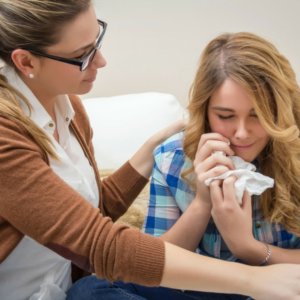Should I be on Red Alert?
As a parent, the fear of your teen developing an eating disorder is both real, and warranted, in the modern world.
I’ve included here some clear and simple points to look out for in your child/teen/pre-adult, that may just help open a dialogue and catch a developing problem early.
Eating disorders usually start in early adolescence and develop largely in secret. This is may be due to two reasons:
the sufferer is often ashamed of the disorder (or being ‘labelled’ as crazy), andthe sufferer believes that this is the only way for him/her to reach the goal s/he is aiming for, and if anyone discovers the issue and intervenes, they will be forced to get ‘fat’ again.
Body-shaming is the new black.
Even more concerning is that currently, there is a popular sentiment amongst teens (girls, especially) that if you are ashamed of your body the way it is (even if slim), then this is ‘good’ and ‘humble’. Being body-confident and NOT dieting is seeing as ‘arrogant’.
This misplaced belief system leads to the teen starting to diet in order to fit in, and so immediately-available information is sought primarily from other teens, the internet and social media. Very rarely, professional dietetic advice is sought, and so fad diets are the first port-of-call.
These fads are usually immediate-gratification diets which are severely restrictive and completely unscientific in their approach.
The result of commencing these ‘diet plans’ is immediate weight loss followed by ‘entry’ into the weight race (as I call it).
The ‘weight-race mentality’ that this kind of starving brain is afflicted with, is driven by obedience to these single-minded obsessions:
‘as long as I’m eating less and hungryas long as I’m losing weight,
I’m ‘winning’.
At what point is it an ‘eating disorder’?
And this ongoing fight against natural hunger to survive, escalates to pathological efforts to attain just that: winning against the body’s natural hunger instincts (which are demonised by the sufferer).
Depending on many factors, the dieter will move on to either:
A: Relenting to the mounting and desperate need for over-compensating feeding habits (bingeing) in order to ‘make up’ for previous starvation efforts. This can rapidly lead to purging efforts as the result of enormous guilt for ‘losing’ to natural desires. (Binge eating disorder or bulimia nervosa)
OR:
B: Realising that the natural survival drive to eat is so strong that unusually drastic and pathological measures are required to maintain restriction. (anorexia nervosa).
What can I do?
Here are some questions you can ask if you are suspecting an eating disorder:
“Are you unhappy with your eating behavior?”
“Are you worried about your weight or your food?”
“Does your weight affect your feeling of self-worth?”
“Do you worry about your figure?”
“Do you eat in secret?”
“Do you vomit when you feel uncomfortably full?”
“Are you worried because sometimes you can’t stop eating?”
Alarmingly, many of these questions may be answered with a ‘yes’ in teens, due to the current popularity of being ‘expected’ to dislike one’s body and live in perpetual restriction. However, as a parent, start this conversation, especially if you notice withdrawal and a change of temperament.
How is it diagnosed by a professional?
The current ICD-10 diagnostic criteria for anorexia nervosa are as follows:
Actual body weight at least 15% below expected weight, or body mass index 17.5 or less (in adults).Weight loss is caused by the avoidance of high-calorie foods and at least one of the following:Self-induced vomitingSelf-induced purgingExcessive exerciseUse of appetite suppressants and/or diureticsDistorted body image as a specific psychological disorderEndocrine disorder, manifest in the female as amenorrhea (cessation of periods) and in the male as a loss of libidoIf onset is prepubertal, the puberty in boys and girls may be delayed (growth ceases; in girls the breasts do not develop)
In a 2011 study conducted by Stephan Herpertz, it was shown in 84 patients with diagnosed anorexia nervosa that 21 years years later, 50% had recovered, but a staggering 15% had died from anorexia-related causes. This warrants increased concern and education of parents in order to increase the likelihood of early intervention and treatment.
ICD-10 diagnostic criteria for bulimia nervosa (F 50.2)
The constant obsession with eating and the overwhelming desire for food leads to episodes of eating large amounts of food in short time periods.There are efforts made to reduce the effect of eating foods perceived as fattening in the form of self-induced vomiting and other purging techniques, alternating episodes of calorie restriction, using appetite suppressants, thyroid preparations or diuretics. People with diabetes may refrain from using their insulin treatment.There is an intense fear of becoming fat, which leads to the desire to reach a specific body weight much lower than is considered normal or healthy for height and age.In many cases, the bulimia follows an episode of anorexia nervosa, although the period of time between the two disorders may vary considerably.
Diagnostic criteria for binge eating disorder
Recurring episodes of binge eating. The two characteristics of a binge eating episode are:Eating a much larger amount of food than most people would consider normal under similar circumstances and within the same time frame (eating may continue for several hours).While eating, there is a feeling of loss of control over the amount of food or type of food being consumed.Binge eating episodes are related to at least three of the following:Eating until feeling uncomfortably full.Eating large quantities of food when not even hungry.Eating noticeably faster than is considered normal.Eating alone due to embarrassment of overeating.Feelings of disgust, depression, or guilt after a binge.There is obvious distress concerning binge eating behavior.On average, binge eating takes place twice weekly, and has done so for 6 months.There are no recurring efforts to compensate for binge eating, such as purging or excessive exercise. The disorder occurs at times other than during episodes of anorexia nervosa or bulimia nervosa.
Why do eating disorders develop?
Eating disorders are strongly associated with other co-morbidities, such as anxiety, chronic depression, obsessive compulsive disorder and borderline personality disorder. Treating one disorder without treating the accompanying problems will lead to a poorer outcome. This is why an integrated treatment team is necessary. However, in vulnerable teens, exposure to incorrect advice plays an increasing role in the development of the disorders.
Considering the prevalence of unqualified diet ‘quacks’ promoting diet fads online, the availability for dangerous advice*** is much more accessible than individualised advice from a registered dietician. This plunges the teen into taking steps that are doomed to succeed initially only to fail repeatedly and thus lower the self-esteem sufficiently for extreme measures to be taken. The combination of a starved mind that is no longer able to think clearly (the physiological changes in the body and brain that accompany caloric restriction drive aggression and food-obsession) and the repeated failures in willpower drive secrecy, obsession and pathology.
It is imperative for parents to highlight what professional should be sought for what problem. If it is gynaecological, seek advice and treatment from a registered and qualified gynaecologist. If it is dietary, seek help from a registered and qualified dietician.
With increased research into this mystifying disorder, recovery statistics are improving. But treatment efficacy depends on the co-operation of the vital players in this team: the psychiatrist, the psychologist, the dietician and the parents.
If concerned, contact a practitioner with eating disorder experience, and a professional assessment can catch a problem before it becomes entrenched and more difficult to treat.
***In my professional opinion, dangerous advice refers to:
diets that are popular because they are marketed well (it is illegal for registered dieticians to solicit-advertise) and enticingly; diets that are designed with a goal in mind (rapid and effective weight loss) but with no thought/knowledge to the physiological dangers associated with eating this way; diets that are designed around calories and macronutrients only; with no consideration of the psychiatric effects of eating this way. Mostly, this is due to lack of training/knowledge in the diet ‘guru’and although unintentional, is still harmful nevertheless.Unsustainable diets that focus on immediate and short-term weight loss, but which lead to long-term metabolic irregularities.
References:
World Health Organization (1992) Clinical Descriptions and Diagnostic Guidelines. Geneva: WHO; The ICD-10 Classification of Mental and Behavioural Disorders
Peterson CB, Mitchell JE, Engbloom S, Nugent S, Mussell MP, Crow S J, Thuras P. Self-help versus therapist-led group cognitive-behavioral treatment of binge eating disorder at follow-up. International Journal of Eating Disorders. 2001;30:363–374.
National Institute of Clinical Excellence Eating Disorders. London: British Psychological Society and Royal College of Psychiatrists; 2004. National Clinical Practice Guideline No CG6.
American Psychiatric Association (APA) Disorders, revised. New York: American Psychiatric Association; 2006. Practice Guideline for the Treatment of Patients with Eating.
Vocks S, Tuschen-Caffier B, Pietrowsky R, Rustenbach SJ, Kersting A, Herpertz S. Meta-analysis of the effectiveness of psychological and pharmacological treatments for binge eating disorder. Int J Eat Disord. 2010;43:205–217. [PubMed]
Hartmann A, Weber S, Herpertz S, Zeeck A. Psychological Treatment for Anorexia Nervosa. A Meta-Analysis of Standardized Mean Change Psychother Psychosom. 2011;80:216–226. [PubMed]
Zipfel S, Löwe B, Reas DL, Deter HC, Herzog W. Long-term prognosis in anorexia nervosa: lessons from a 21-year follow-up study. Lancet. 2000 Feb 26;355(9205):721-2.
Herpertz S, Hagenah U, et al. The diagnosis and treatment of eating disorders. Dtsch Arztebl Int. 2011 Oct;108(40):678-85.







